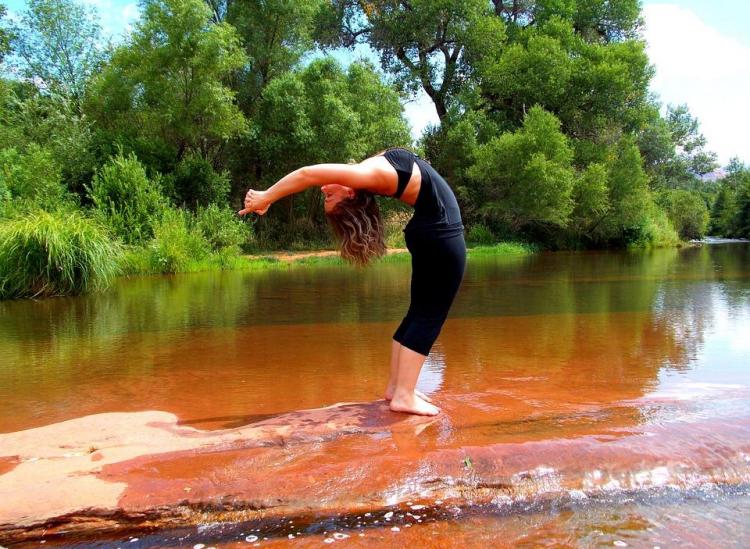5 Yoga Poses You Need To Try When You’re Pissed Off

Pixabay
Let’s face it: we all have emotional triggers, and sometimes the sting they leave behind lasts longer than it should. Bringing movement into the body can be one of the best ways to rid yourself of this negative energy and replace it with an overall sense of calm and grounding.
While some people opt for a quick outdoor jog or a killer kickboxing class, there are certain yoga poses for anger that not only soothe the soul, but also bring you back to a more mindful place. Sounds like a win-win to us. Give these five postures a try when you really need help simmering down.
1. Half Lord Of The Fishes Pose (Ardha Matsyendrasana)
Half-twist poses like Ardha Matsyendrasana massage your internal organs as well as stretch your spine. And Buddhist monks thought that this posture in particular could help literally wring anger out of the body.
Once you’re seated, bend both knees. Lift your left leg a bit so you can slide your bent right leg across your body on the floor, and then place your left foot on the floor. Place your left hand on the floor behind you at the base of your spine (think of it as an anchor for your body). Reach your right hand up to the sky and then bring it across your body so that your tricep connects with the outside of your left thigh. Gently twist toward the left, using your arms as leverage. As you inhale, grow taller in your seat. As you exhale, twist deeper. When you’re ready, unravel to the starting position and switch sides.
2. Upward Bow Pose (Urdhva Dhanurasana)
This heart-opening backbend can help reduce feelings of anger and hostility while boosting energy. Begin by lying on the floor. Bend your knees and place your feet flat on the floor with your heels as close to your torso as possible. Bend your elbows and place your hands flat on the floor directly above your shoulders. Now, root down through your feet and lift your hips off the floor into a bridge. Take a breath and lift your shoulders off the floor, gently resting on the crown of your head with your arms, legs and glutes engaged. As you take your next breath, lift your head and straighten your arms. Keep your knees in line with your hips (they tend to splay outward) as you spread your shoulder blades. Let your head hang as you breathe. When you’re ready to rest, bend your elbows and slowly bring the back of your head and shoulders down to your mat first. Then slowly bring the rest of your torso down to your mat one vertebrae at a time.
3. Supported Shoulder Stand (Salamba Sarvangasana)
This inversion helps to stabilize your nervous system (and therefore your mood). Lying on your back, carefully lift your legs and bring your feet behind your head so that you’re in Plow Pose. Your weight should be resting in the top of your shoulders. Bring your hands to the base of your lower back and press your forearms and elbows into your mat along the sides of your body to create a support. Once your arms feel stable, slowly lift one leg up toward the sky and then let the other join it. Straighten your spine and reach through your toes as you press down into your elbows. Your weight should be in your arms and shoulders rather than your head and neck. Breathe deeply here until you’re ready to rest. To come out of the pose, slowly lower one leg at a time back to Plow Pose, bend your knees and roll your torso back down to your mat one vertebrae at a time as you bring your arms out from underneath your torso.
4. Child’s Pose (Balasana)
This deep stretch allows for a little introspection as you simply rest your forehead on your mat and breathe. Start by coming to a kneeling position on your mat. Bring your knees to the edges of your mat and your feet directly beneath your hips. As you exhale, lay your torso in between your thighs and reach your arms directly in front of you. Let the weight of your arms rest on your mat with your palms facing down and your fingers spread wide. As you breathe and melt further into floor, feel the stretch in your shoulders, back and hips. And when you’re ready to move on from this pose, use your hands to slowly push your torso back to an upright position and sit on your heels.
5. Corpse Pose (Savasana)
Also referred to as the total relaxation pose, this posture can one of the most meditative and grounding ones available to anyone at any fitness level. Simply lie on your back and let all four of your limbs relax. Your head, neck, shoulders and hips should be in a neutral position. Allow your legs to splay out naturally (even bend your knees if that’s more comfortable) and turn your palms up to face the sky as your arms and shoulders rest. Close your eyes. Let your tongue relax away from the roof of your mouth and soften the skin on your forehead. Just focus on taking slow, deep, even inhales and exhales. When you’re ready to leave the pose, gently roll onto your right side, bending your knees toward your chest and resting your head on the inside of your right arm. Then slowly lift your torso toward a seated position, bringing your head up last.











